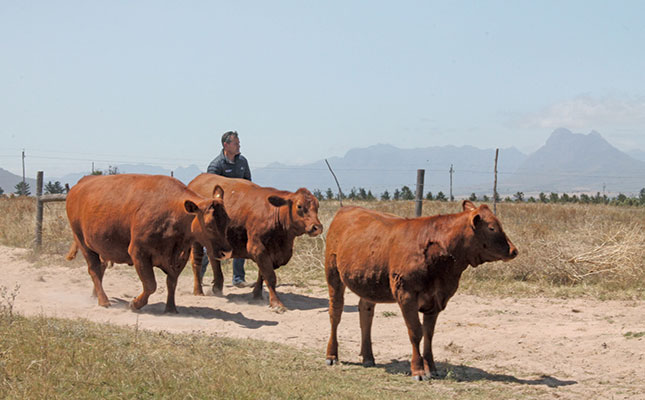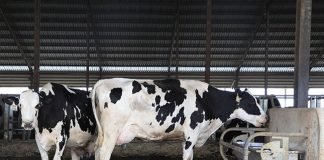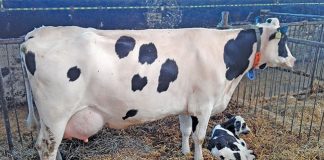
Photo: Jeandré van der Walt
“It started as a hobby in 2012, when we bought a few commercial Angus cows,” says Theuns Bruwer. His wife, Debbie, had been nagging him to spend less time in front of the TV and find a hobby. She had previously assisted Pierre Veldhoen and his wife, Nella, with their Friesian horse stud on their 80ha farm, Dagbreek, just outside Paarl.
Veldhoen and his wife immigrated to South Africa from the Netherlands a few years ago to breed Friesian horses. Due to economic difficulties, they scaled down operations, and no longer breed Friesians.
This presented Bruwer with the ideal opportunity to begin a cattle farming operation on the underutilised land, and Bruwer and Veldhoen now run an Angus stud on 60ha on the farm.
Building the herd
“According to our research, the Angus breed is the most prevalent in the Cape. It is also renowned for its good temperament, easy calving and good calf-rearing ability,” says Bruwer.
He and Veldhoen initially bought a few commercial Angus cows. The following year, they bought red Angus embryos from a breeder in the Free State, and used their commercial cows as surrogates.
In 2013, they registered the Windmeul Angus stud. Initially running a commercial herd and the stud, they sold all their commercial animals in 2015, and now manage only the stud. It consists of 14 female Angus animals: nine red and five black.
The stud is run on mainly natural veld. The farm is stocked at a carrying capacity of 1 MLU/8ha.
“We have really good grazing for about three to four months of the year. The rest of the year, grazing is scant, but the animals are not stressed at any point,” says Bruwer.
The animals receive a lick throughout the year with the necessary trace elements, a protein lick in summer when pastures are dry, and an energy lick in winter. With the turn of the seasons, the animals also receive a phosphate lick. However, Bruwer believes that animals must know how to utilise any grazing, and provides as little extra feed as possible.
“The only time our animals get additional rations is when we want to make them show-ready. It’s only a select few that get these extra rations. We also make sure that the animals get vitamin A injections. I’m a big supporter of Multimin for the cows and Kyroligo for the younger animals.”
In January, all animals are vaccinated with Supavax and Respiravax. These vaccines protect against blackquarter (sponssiekte), bovine viral diarrhoea and anthrax (miltsiekte). In April, they are vaccinated against lumpy skin disease, and are dipped regularly for ticks, especially in summer. Every second year, all animals are tested for bovine tuberculosis and brucellosis.
Breeding plan
Bruwer looks for structurally sound females. “I prefer medium-sized female animals: broad and full of meat, but also feminine,” he says.
Artificial insemination (AI) is exclusively used in the herd.
Bruwer, who works for World Wide Sires South Africa, performs the insemination himself.
The calving rate is 90%. He says the bulls used should have a strong female lineage, considering Windmeul Angus’s strong focus on female animals. They should also be masculine.
“We do thorough homework on the bulls before any insemination is done.”
The breeding season runs from July to September. As the herd is small, Bruwer rarely uses synchronisation, and injects the female animals with a dose of luteolytic agents (Estrumate or Lutalyse) and allows them to reach their heat cycle naturally.
Heifers are inseminated from 15 months. However, if he feels they are too small, he waits until they are 18 months old.
Due to rigorous selection, Bruwer says he has eliminated all animals that do not respond well to hormone therapy. Therefore, few animals do not conceive during the first insemination.
Animals receive a dose of Multimin a month before calving, and then again as soon as they give birth.
“If the first insemination doesn’t take, I will try another two times. I will stop after the third attempt and then try to figure out why she is not pregnant. There is always a reason.”
In-calf animals are treated the same as the rest of the herd, and don’t receive any additional supplements. The average inter-calving period is currently between 350 and 360 days.
Ensuring quality
Heifers are either retained for the stud’s own purposes, or sold.
“I don’t think we have a cow anymore that can’t be used for stud purposes.”
Bull calves are sold for slaughter once they are weaned.
“We only raised one bull and took it all the way through to an auction. Bulls are a high risk. If a bull is not 100% right, it can cost you a lot of money.”
Because of the breed’s good milk production, calves are weaned at between 290kg and 310kg, says Bruwer.
He adds that if an animal does not meet their strict standards, it is slaughtered.
Winning stud
Despite Windmeul Angus starting off as a hobby, Bruwer and Veldhoen have achieved remarkable success.
“For the past three years, we have been blessed with good results. Red Anny 1403-et has been crowned Agri Expo Livestock’s Big Champion Red Angus Cow for the past three years. This year, she also won the BKB Supreme Beef Queen award.”
In 2018, Anny was also the Grand Champion Angus Cow at the Swartland Show in Moorreesburg. Her eldest daughter, 1801, was crowned the Tiny Tot Champion at the Swartland Show and at Agri Expo Livestock in 2018. “In 2019, she was also named the National Calf Champion at the Swartland Show.”
Bruwer says it’s not just their red cows that perform well. “In 2019, our black Angus heifers also performed well during the SA Angus National Championships at the Swartland Show. Windmeul Alet 1803 was named the National Heifer Calf and Windmeul Foxy Lady 1802 was the Reserve Champion.”
In 2018, Windmeul Angus was named the Southern Cape and Western Cape Angus Club’s Show Breeder of the Year. Bruwer’s latest award came from the South African Angus Breeders’ Association, which recognised him as the best young breeder in the country.
Keeping it exclusive
Despite their success, the pair say they did face some challenges. Veldhoen says rainfall on the farm averages 400mm/ year, most of it in winter. However, in 2015, they did not receive much more than 200mm.
“It was a challenging year for us because of the drought. In addition, we still kept a large number of commercial animals with our stud animals. The result was that our stud animals started to suffer as they had to share the little pasture that was left with the commercial animals,” Veldhoen says.
Bruwer adds that they decided to sell their commercial cows to focus exclusively on stud animals.
“By keeping our stud small, attention to detail is just so much better. It also allows us to work with the very best genetics.”
Thanks to a smaller herd, they can also easily keep tabs on the welfare of the cattle. Bruwer checks on the cows at least three times a day. He adds that they also decided to keep their stud small so that they can be exclusive.
They therefore have no plans to extend the size of the stud. In this way, they plan to focus more on the finer details of genetics to deliver top-quality animals.
Before buying any foundation stock, prospective stud farmers should first familiarise themselves with the breed they want to farm, says Bruwer.
“The most successful stud farmers are not the richest farmers who buy the most expensive cows and bulls. It is the farmers who know their breeds and have a thorough knowledge of how to improve their herds.”
He says it’s vital to seek advice from reputable and respected role players in the industry.
“Speak to members of a breed association, or show judges, to broaden your knowledge of the breed you want to farm.”
It is also critical to select a breed suitable for local conditions.
“Angus are popular in the Boland and do well on grass. So it was a no-brainer for us to farm the breed. Start small, but do it right. We only bought one animal at a time. It takes patience, but in the end it is rewarding.”
Email Theuns Bruwer at [email protected].













